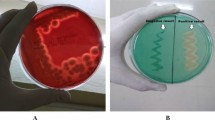Abstract
The aim of this study was to assess the diagnostic properties of the two selective plating media and a chromogenic medium for identification of Bacillus cereus. The 324 isolates were B. cereus (37%), Bacillus weihenstephanensis (45%) or Bacillus thuringiensis (18%), as identified by a new combination of techniques. All isolates were growing on mannitol–egg yolk–polymyxin agar (MYP), and they did not form acid from mannitol. However, a significant lower number of B. thuringiensis isolates did not show lecithinase activity. All isolates were also growing on polymyxin–egg yolk–mannitol–bromothymol blue agar (PEMBA); however, 11% isolates indicated that they did produce acid from mannitol, and 15% isolates did not show any lecithinase activity. Five of the isolates did not grow at all on the chromogenic agar, and 14 of the growing isolates were β-glucosidase negative. It is concluded that the two recommended selective plating media MYP and PEMBA for detection of B. cereus group bacteria both have their limitations for identification of some B. cereus, B. weihenstephanensis or B. thuringiensis. However, MYP is preferable compared to PEMBA. The chromogenic medium has its own advantages and limitations, and some of the limitations seem to be solved by incubation at 30°C instead of the recommended 37°C.
Similar content being viewed by others
References
Anonymous (2003) Bacillus cereus. Determination in food. Nordic Committee on Food Analysis 67, 5th edn.
Anonymous (2004) Microbiology of food and animal feeding stuffs—horizontal method for the enumeration of presumptive Bacillus cereus—colony-count technique at 30 degrees C. ISO 7931:2004, TC34/SC 9
Arnesen LPS, Fagerlund A, Granum PE (2008) From soil to gut: Bacillus cereus and its food poisoning toxins. FEMS Microbiol Rev 32:579–606
Bottone EJ (2010) Bacillus cereus, a volatile human pathogen. Clin Microbiol Rev 23:382–398
Cheun HI, Makino SI, Wataral M, Shirahata T, Uchida I, Takeshi K (2001) A simple and sensitive detection system for Bacillus anthracis in meat and tissue. J Appl Microbiol 91:421–426
Ehling-Schulz M, Fricker M, Scherer S (2004) Bacillus cereus, the causative agent of an emetic type of food-borne illness. Molecular Nutrition and Food Research 48:479–487
Fricker M, Reissbrodt R, Ehling-Schulz M (2008) Evaluation of standard and new chromogenic selective plating media for isolation and identification of Bacillus cereus. Int J Food Microbiol 121:27–34
Gohar M, Gilois N, Graveline R, Sanchis V, Lereclus D (2005) A comparative study of Bacillus cereus, Bacillus thuringiensis and Bacillus anthracis extracellular proteomes. Proteomics 5:3696–3711
Hansen BM, Leser TD, Hendriksen NB (2001) Polymerase chain reaction assay for the detection of Bacillus cereus group cells. FEMS Microbiol Lett 202:209–213
Hendriksen NB, Hansen BM, Johansen JE (2006) Occurrence and pathogenic potential of Bacillus cereus group bacteria in a sandy loam. Antonie van Leeuwenhoek 89:239–249
Logan NA (1988) Bacillus species of medical and veterinary importance. J Med Microbiol 25:157–165
Martin PAW, Gundersen-Rindal DE, Blackburn MB (2010) Distribution of phenotypes among Bacillus thuringiensis strains. Sys Appl Microbiol 33:204–208
Rhodehamel EJ, Harmon SM (1998) Bacillus cereus. In: US Food and Drug Administration (ed) Bacteriological analytical manual, 8th edn, revision A. AOAC International, Gaithersburg. http://www.cfsan.fda.gov/∼ebam/bam-14.html
Schulten SM, in’t Veld PH, Nagelkerke NJD, Schotter S, de Buyser ML, Rollier P, Lahellec C (2000) Evaluation of the ISO 7932 standard for the enumeration of Bacillus cereus in foods. Int J Food Microbiol 57:53–61
Travers RS, Martin PAW, Reichelderfer CF (1987) Selective process for efficient isolation of soil Bacillus spp. Appl Environ Microbiol 53:1263–1266
Van Netten P, Kramer JM (1995) Media for the detection and enumeration of Bacillus cereus in foods. In: Corry JEL (ed) Culture media for food microbiology. Elsevier, Amsterdam, pp 35–49
Von Stetten F, Francis KP, Lechner S, Neuhaus KA, Scherer S (1998) Rapid discrimination of psychrotolerant and mesophilic strains of the Bacillus cereus group by PCR targeting of 16S rDNA. J Microbiol Methods 34:99–106
Acknowledgements
We thank Tina Thane for excellent and experienced technical assistance. The study was partly financed by an EU-funded research project “AEROBACTICS” (Assessment of the quantity, identity, viability, origin and dispersion of airborne micro-organisms for application in crisis management tools, grant agreement no. SEC6-PR-214400).
Author information
Authors and Affiliations
Corresponding author
Rights and permissions
About this article
Cite this article
Hendriksen, N.B., Hansen, B.M. Diagnostic properties of three conventional selective plating media for selection of Bacillus cereus, B. thuringiensis and B. weihenstephanensis . Folia Microbiol 56, 535–539 (2011). https://doi.org/10.1007/s12223-011-0079-0
Received:
Accepted:
Published:
Issue Date:
DOI: https://doi.org/10.1007/s12223-011-0079-0




